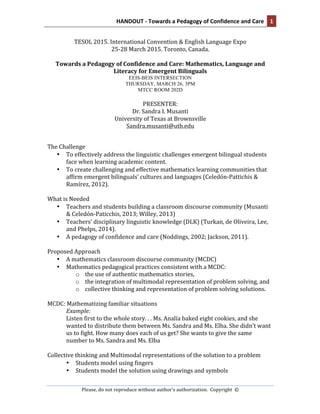More Related Content
Similar to Musanti eeis-beis intersection-handout
Similar to Musanti eeis-beis intersection-handout (20)
Musanti eeis-beis intersection-handout
- 1. HANDOUT
-‐
Towards
a
Pedagogy
of
Confidence
and
Care
1
Please,
do
not
reproduce
without
author’s
authorization.
Copyright
©
TESOL
2015.
International
Convention
&
English
Language
Expo
25-‐28
March
2015.
Toronto,
Canada.
Towards
a
Pedagogy
of
Confidence
and
Care:
Mathematics,
Language
and
Literacy
for
Emergent
Bilinguals
EEIS-BEIS INTERSECTION
THURSDAY, MARCH 26, 3PM
MTCC ROOM 202D
PRESENTER:
Dr.
Sandra
I.
Musanti
University
of
Texas
at
Brownsville
Sandra.musanti@utb.edu
The
Challenge
• To
effectively
address
the
linguistic
challenges
emergent
bilingual
students
face
when
learning
academic
content.
• To
create
challenging
and
effective
mathematics
learning
communities
that
affirm
emergent
bilinguals’
cultures
and
languages
(Celedón-‐Pattichis
&
Ramírez,
2012).
What
is
Needed
• Teachers
and
students
building
a
classroom
discourse
community
(Musanti
&
Celedón-‐Paticchis,
2013;
Willey,
2013)
• Teachers’
disciplinary
linguistic
knowledge
(DLK)
(Turkan,
de
Oliveira,
Lee,
and
Phelps,
2014).
• A
pedagogy
of
confidence
and
care
(Noddings,
2002;
Jackson,
2011).
Proposed
Approach
• A
mathematics
classroom
discourse
community
(MCDC)
• Mathematics
pedagogical
practices
consistent
with
a
MCDC:
o the
use
of
authentic
mathematics
stories,
o the
integration
of
multimodal
representation
of
problem
solving,
and
o collective
thinking
and
representation
of
problem
solving
solutions.
MCDC:
Mathematizing
familiar
situations
Example:
Listen
first
to
the
whole
story.
.
.
Ms.
Analía
baked
eight
cookies,
and
she
wanted
to
distribute
them
between
Ms.
Sandra
and
Ms.
Elba.
She
didn’t
want
us
to
fight.
How
many
does
each
of
us
get?
She
wants
to
give
the
same
number
to
Ms.
Sandra
and
Ms.
Elba
Collective
thinking
and
Multimodal
representations
of
the
solution
to
a
problem
• Students
model
using
fingers
• Students
model
the
solution
using
drawings
and
symbols
- 2. 2
Towards
a
Pedagogy
of
Confidence
and
Care
Please,
do
not
reproduce
without
author’s
authorization.
Copyright
©
• Teacher
includes
the
algorithm
• Teachers’
disciplinary
linguistic
knowledge
(DLK)
Teachers’
disciplinary
linguistic
knowledge
(DLK)
DLK
is
proposed
as
the
knowledge
base
needed
to
facilitate
ELLs’
understanding
of
oral
and
written
discourse
within
a
discipline
and
their
accurate
use
of
language
to
engage
them
in
the
disciplinary
discourse.
(Turkan,
De
Oliveira,
Lee
&
Phelps,
2014).
DLK
involves
awareness
of
how
language
is
connected
to
mathematics
learning:
• Identify
specific
linguistic
elements
in
mathematics
discourse
(i.e.
multiple
representations,
use
of
algorithms)
• Model
for
bilingual
students
how
to
communicate
meaning
(i.e.
math
stories,
reading
the
algorithm,
retelling,
revoicing
students’
thinking)
• Engage
students
in
the
mathematics
discourse
both
orally
and
in
writing
(i.e.
students’
listen
to
teacher,
listen
to
each
other,
created
their
own
problems)
As
a
conclusion:
A
pedagogy
of
confidence
and
care
Emergent
bilingual
students
need
teachers
who
care
to
operate
from
a
framework
where
confidence
and
understanding
are
the
pillars
for
redefining
a
bilingual
classroom
teaching
approach
• focused
on
building
a
mathematics
discourse
community.
• confidence
on
emergent
bilingual
students’
learning
capabilities
• proposing
a
challenging
mathematics
curriculum
• understanding
of
students’
mathematical
thinking
and
learning
needs
Implications
for
Practice
• Create
classroom
environments
that
are
rich
in
language
and
mathematics
content.
This
can
be
achieved
by
providing
students
with
multiple
opportunities
to
solve
challenging
mathematics
problems
and,
in
addition,
by
allowing
students
to
create
their
own
mathematics
stories.
• Integration
of
multimodal
ways
to
represent
meaning:
Connection
of
language
with
mathematical
representations
(e.g.,
pictures,
symbols,
tables,
graphs,
equations)
and
encouragement
of
students
to
orally
explain
the
different
ways
they
find
to
solve
the
problems.
• Emphasis
on
meaning
and
the
multiple
meanings
of
words:
Identification
of
relevant
information
in
the
stories,
using
the
information
to
think
about
the
story
and
the
possible
ways
to
represent
a
solution.
• Collective
construction
of
problem
solving
strategies
and
arguments
to
explain
thinking
• Enactment
of
a
pedagogy
of
confidence
and
care:
Value
students’
answers
and
their
use
of
language
resources,
and
position
students
as
mathematics
learners
by
challenging
them
with
progressively
more
difficult
mathematics
problems.
- 3. HANDOUT
-‐
Towards
a
Pedagogy
of
Confidence
and
Care
3
Please,
do
not
reproduce
without
author’s
authorization.
Copyright
©
References
Celedón-‐Pattichis,
S.
&
Ramírez,
N.
G.
(Eds.).
(2012)
Beyond
good
teaching:
Advancing
mathematics
education
for
ELLs.
Reston,
VA:
National
Council
of
Teachers
of
Mathematics.
Civil,
M.,
&
Turner,
E.
(2014).
The
common
core
state
standards
in
mathematics
for
English
language
learners:
Grades
K-‐8
.
Alexandria,
VA:
TESOL.
Jackson,
Y.
(2011).
The
pedagogy
of
confidence:
Inspiring
high
intellectual
performance
in
urban
schools
.New
York,
NY:
Teachers
College
Press.
Moschkovich,
J.
N.
(2012,
January).
Mathematics,
the
common
core,
and
language:
Recommendations
for
mathematics
instruction
for
ELs
aligned
with
the
common
core.
Paper
presented
at
Understanding
Language
Conference,
Stanford
University,
Stanford,
CA.
Available
at:
http://ell.stanford.edu/
Musanti,
S.
I.,
&
Celedón-‐
Pattichis,
S.
(2012).
“
They
need
to
know
they
can
do
math”:
Reaching
for
equity
through
the
native
language
in
mathematics
instruction
with
Spanish
speaking
students.
Journal
of
Bilingual
Education
Research
&
Instruction,
14
(1),
80-‐94.
Noddings,
N.
(2002).
Starting
at
home:
Caring
and
social
policy
.
Berkeley,
CA:
University
of
California
Press.
Turkan,
S.,
de
Oliveira,
L.,
Lee,
O.,
&
Phelps,
G.
(2014).
Proposing
a
knowledge
base
for
teaching
academic
content
to
English
language
learners:
Disciplinary
linguistic
knowledge.
Teachers
College
Record,
116(4).
Turkan,
S.,
&
Schramm-‐Possinger,
M.
(2014,
June).
Teaching
content
to
English
learners
in
the
era
of
the
Common
Core
Standards.
R&D
Connections,
23.
